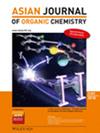通过形成季碳中心C(sp3)─N键的N-磺酰-1,2,3-三唑的高区域选择性丁化反应
IF 2.7
4区 化学
Q1 CHEMISTRY, ORGANIC
引用次数: 0
摘要
以N-磺酰基-1,2,3-三唑和过氧化叔丁基为原料,建立了一个以季碳为中心的C(sp3)─N键形成的高效例子,在不需要任何额外催化剂或添加剂的情况下,具有高的区域选择性和良好的收率(71%-83%)。这一前所未有的反应可能是由三唑的自由基加成和芳基脱硫过程引起的。本文章由计算机程序翻译,如有差异,请以英文原文为准。

Highly Regioselective Butylation of N‐Sulfonyl‐1,2,3‐triazoles by the Formation of Quaternary Carbon‐Centered C(sp3)─N Bonds
An efficient example of quaternary carbon‐centered C(sp3)─N bond formation has been developed using N‐sulfonyl‐1,2,3‐triazoles and tert‐butyl hydroperoxide with a high regioselectivity in good yields (71%–83%) without any additional catalysts or additives. The unprecedented reaction was possibly promoted by a radical addition to triazoles followed by an aromatic desulfonation process.
求助全文
通过发布文献求助,成功后即可免费获取论文全文。
去求助
来源期刊

Asian Journal of Organic Chemistry
CHEMISTRY, ORGANIC-
CiteScore
4.70
自引率
3.70%
发文量
372
期刊介绍:
Organic chemistry is the fundamental science that stands at the heart of chemistry, biology, and materials science. Research in these areas is vigorous and truly international, with three major regions making almost equal contributions: America, Europe and Asia. Asia now has its own top international organic chemistry journal—the Asian Journal of Organic Chemistry (AsianJOC)
The AsianJOC is designed to be a top-ranked international research journal and publishes primary research as well as critical secondary information from authors across the world. The journal covers organic chemistry in its entirety. Authors and readers come from academia, the chemical industry, and government laboratories.
 求助内容:
求助内容: 应助结果提醒方式:
应助结果提醒方式:


